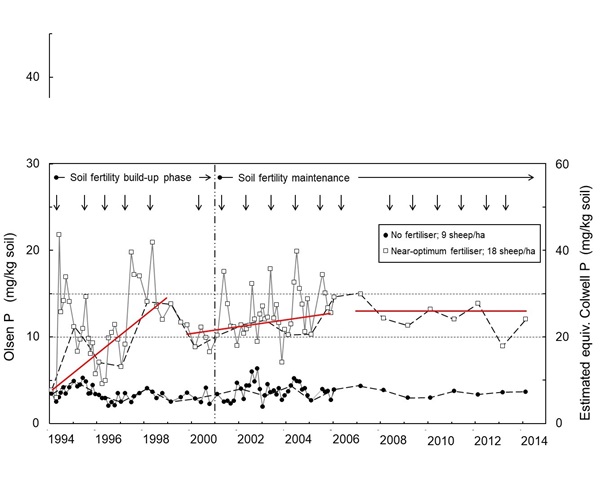Time for a new approach to pasture soil testing
Regular soil testing should be a key management practice in any farming system. The science behind the critical nutrient values is well founded and there’s no disputing the lost production due to nutrient deficiencies or the unnecessary cost involved with over applying fertilisers.
Click to download this article
Unfortunately, soil testing is simply not on the agenda for many producers. Taking a soil sample is much easier than marking a calf or shearing a sheep, yet according to a Meat & Livestock Australia report from 2014, less than 25% of producers across all sectors were likely to have soil tested and less than 15% of all soil tests submitted were from pasture paddocks.1
Producers who are choosing to soil test are generally doing so every five to eight years. But that’s a long time to wait for good nutrient guidance and fertiliser recommendations, or to check on the success of a fertiliser program.
That’s why it’s time for a better approach to soil testing – the annual monitoring of key nutrients paired with comprehensive soil tests undertaken every three to five years. This will allow producers to better manage their pastures using long term trends and more rapidly adjust to changes in key nutrient values.
“It’s time for a better approach to soil testing – the annual monitoring of key nutrients paired with comprehensive soil tests undertaken every three to five years.”
One of the leading advocates for the new soil sampling regime is Richard Simpson, a pasture researcher with CSIRO based in Canberra. He believes that sampling paddocks every year for key nutrients, particularly for phosphorus (P), reduces the noise associated with single data points and better shows soil fertility trends over time. Soil testing every year helps eliminate sampling errors caused by spatial and temporal variability. By contrast, if advisers are relying on a single data point from a single soil test, they may be vulnerable to a sampling error being reflected all the way through to fertiliser choice and rate recommendations.
This can be seen in Figure 1, which shows a long-term CSIRO grazing trial at Ginninderra, where a regular testing regime was used to monitor soil phosphorus levels. This trial highlights the variability of soil test P values within a growing season and the variation observed from year to year. It demonstrates how using one year’s soil test information may be misleading. The trends over time using the annual sampling build a clearer picture.

Figure 1: Soil test P results from a long-term grazing experiment at CSIRO’s Ginninderra Experiment Station.
(Redrawn from Simpson et al. (2015) Agriculture, Ecosystems & Environment 212, 263-277.)
Soil tests were taken initially at about 6-week intervals. The results show that P availability is seasonally variable. Soil tests were taken annually at the same time each year over the last 9 years of the experiment, and when these points are combined with the same time points among the earlier soil tests (see dashed line), they show what annual soil testing will look like on a farm. The annual tests are not subject to extreme seasonal variations, but they still vary because soil and climatic conditions are different in different years. Trends developed using annual data collected over time (e.g. red lines) are the best way to check and adjust fertiliser management. It would not be possible to draw these trend lines without the annual data points. For more information on the design and objective of this experiment, contact richard.simpson@csiro.au.
Phosphorus is the primary nutrient for consideration in pasture systems and annual P data trends can hone fertiliser application strategies, whether that be for maintenance applications, capital applications or mining soil phosphorus. Two other nutrients which could be considered for annual testing are potassium (K) and sulphur (S).
If potassium values are marginal, or nutrient removal is significant due to fodder conservation, then an annual Colwell K test is a good strategy. Just as for phosphorus, testing potassium annually will allow producers to track trends over time and ensure the potassium fertiliser program is having the desired effect. Where soil potassium levels are adequate, Colwell K testing could move out to a frequency of every three to five years.
Sulphur is a mobile nutrient in the soil and cycles through organic matter, so there can be significant variations in sulphur levels due to seasonal conditions and management practices. An annual S soil test is recommended, unless a sulphur-based fertiliser like SuPerfect® is used regularly.
Ideally, these annual soil tests for key nutrients should be taken at the same time each year. Spring is a great time because soil moisture and temperature are typically constant, which is good for the consistency of data over time. Any abnormal pasture growth is clearly visible during the spring growth period, so these areas can be avoided, i.e. dung and urine patches.
A soil testing program should always start with a comprehensive soil test and this should be repeated every three to five years to check on soil factors such as pH, PBI, cation exchange capacity, soil texture and organic carbon. These are all relatively stable in the short term.
The overall cost of annual testing for key nutrients is similar to less frequent, comprehensive testing. More importantly, however, it allows producers to make focused and confident fertiliser investments based on soil nutrient trends.
Table 1 shows the options available for an updated soil testing regime for pastures. All of these soil test options are available in packages or as a single nutrient from the NATA accredited Nutrient Advantage® laboratory. The Nutrient Advantage laboratory offers a high-quality accredited soil, plant and water testing service for advisers and farmers across Australia.
Table 1: New approach to soil testing in pastures
|
|
Options for comprehensive testing every 3-5 years |
Options for key nutrient testing every year |
||||||||
|
Analyte |
E22 |
E23 |
E20* |
Customised test options for monitoring only
|
||||||
|
Phosphorus (Olsen) |
+ |
+ |
|
+ |
|
+ |
|
+ |
+ |
|
|
Phosphorus (Colwell) |
+ |
+ |
+ |
|
+ |
|
+ |
|
+ |
+ |
|
PBI |
+ |
+ |
+ |
|
|
|
|
|
|
|
|
Potassium (Colwell) |
+ |
+ |
+ |
|
|
+ |
+ |
|
|
+ |
|
Sulphur (KCL 40) |
+ |
+ |
+ |
|
|
|
|
+ |
+ |
+ |
|
pH (1:5 Water & CaCl) |
+ |
+ |
|
|
|
|
|
|
|
|
|
Exchangeable Al (KCl) |
+ |
+ |
|
|
|
|
|
|
|
|
|
EC (1:5 water) |
+ |
+ |
|
|
|
|
|
|
|
|
|
Chloride |
+ |
+ |
|
|
|
|
|
|
|
|
|
Ammonium & Nitrate N |
+ |
+ |
|
|
|
|
|
|
|
|
|
Organic Carbon (Walkley & Black) |
+ |
+ |
|
|
|
|
|
|
|
|
|
Exchangeable Cations (Ca, K, Mg, Na, CEC) |
+ |
+ |
|
|
|
|
|
|
|
|
|
Texture and Soil Colour |
+ |
+ |
|
|
|
|
|
|
|
|
|
Boron (hot CaCl2) |
|
+ |
|
|
|
|
|
|
|
|
|
Copper, Iron, Manganese, Zinc (DTPA) |
|
+ |
|
|
|
|
|
|
|
|
* Olsen P is available as an optional extra on the new E20 test code.
Consider the new approach to soil testing in pastures and how it might work in your business. To discuss any aspect of soil testing, feel free to contact me on lee.menhenett@incitecpivot.com.au or 0412 565 176.
1 An assessment and benchmarking of phosphorus nutrient use efficiency and industry management practice in southern Australia, Meat & Livestock Australia (https://www.mla.com.au/research-and-development/search-rd-reports/final-report-details/Productivity-On-Farm/An-assessment-and-benchmarking-of-phosphorus-nutrient-use-efficiency-and-industry-management-practice-in-southern-Australia/1078#)


